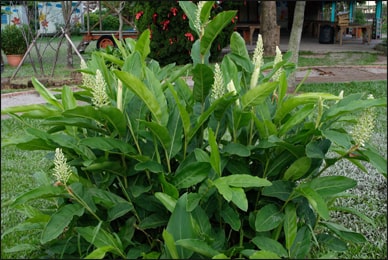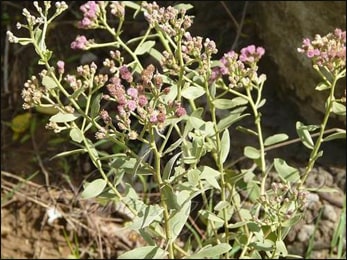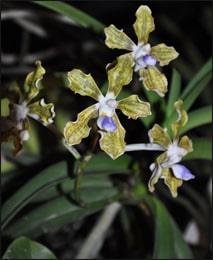Rasna (Alpinia Galanga) – Uses, Health Benefits, Medicinal Properties

(Ref: Bhavaprakasa Nighantu)
Introduction

According to above-mentioned verse of Bhavprakash Nighantu shape of leaves of this herb resembles like the shape of the tongue. This herb of Ayurveda is used to pacify vitiated vata dosh in the body and very beneficial for curing various vata disorders. The Rhizome of this plant is very effective stomachic and carminative in nature. The Rhizome of this plant is also used in Thai and Indonesian cuisines.
Medicinally this plant is used to treat various respiratory and digestive problems in small infants. Seeds of this plant fight against bad odour of mouth and other dental caries. It increases appetite, stimulate digestive power and act as an effective laxative. Essential oil obtained from this herb is used to reduce inflammation of nervous system and joints of the body. It is anti-microbial in nature that aid with various infection causing micro-organisms.
Plant Description
Alpinia galanga is a perennial herbaceous plant that attains a maximum height of 3-4mt. Branches of this plant are creeping with a cluster of leaves. Dark green leaves of the plant are long and broad at the base and narrow at the tips. The Rhizome of a plant is approximately 7cm long and light reddish or pale yellow in colour. Flowers of the plant are about 3cm long and greenish white in colour. Flowering season of the plant is May-June and fruiting season of the plant is August-September. Fruits of the plant are small cherries and reddish-orange in colour.
Habitat
Alpinia galanga is basically native to Indonesia and South Asia. This beneficial plant is also cultivated in Malaysia, Thailand, Sri Lanka and Myanmar for its commercial and various health benefits. In India, it is distributed in Himalayas, Bihar, Assam, and West Bengal. It grows in a sunny area with sufficient amount of rainfall.
Names
- Latin name – Alpinia galanga
- English name – Thai ginger, Siamese ginger, Greater galangal
- Sanskrit name – Dhumala, Dhumparastma
- Philippines name – Langakawas
- Hindi name – Bara kulanjan
- Manipuri name – Kanghu
- Kannada name – Dhumarasmi
- Malayalam name – Aratta
- Marathi name – Kosht-kulinjan
- Tamil name – Aruttai
- Urdu name – Kuknjan
According to Bhavprakash Nighantu

According to above-mentioned verse of Bhavprakash Nighantu rasna, yukatrasa, rasna, rasa, elaparni, sursa, sugandha and shreyasi are the various synonyms of herb rasna. Rasna is heavy in nature, bitter in taste, hot in potency and used to pacify Kapha dosha in the body. It helps to stimulate digestive fire and used to cure inflammation, asthma, gout, pain, digestive disorders, cough, fever and poisoning. This herb is used to treat 80 types of vata disorders.
Reference:-
The Bhavprakash Nighantu with elaborated Hindi commentary of Padamshri Prof Krishna Chander Chunnekar and edited by Dr. Gangasahay Pandey: edition 2010; page number – 76 and verse number – 162, 163 and 164.
Uses of Rasna (Alpinia Galanga)
- 1gm of rasna powder, saunth, gond and afeem is used to treat diarrhoea and abdominal tumours.
- Rasna powder, ghodvach and mulethi are used to treat various kapha dosha in the body.
- It is used to eliminate impurities and blood from uterus after delivery.
- The paste of 10cm long rhizome is used to induce vomiting in cases of indigestion. 1-2gm of leaf powder is also used to induce vomiting to excrete out Kapha dosha in the body.
- It is used as rasayana and blood purifier to remove impurities from the blood.
- Rasna is also used to cure gout, joint pain, body aches and used as an antidote for snake poisoning.
- Rhizome paste is applied externally to reduce stiffness and pain in cases – of gout.
Health Benefits of Rasna (Alpinia Galanga)
- Vamak – It is very effective emetic in nature, maximum 3gm of powder of this herb is used to induce vomiting to eliminate dosha from the body.
- Kapha nisarak – It also helps to pacify Kapha dosha in the body. It help to excrete extra phlegm and congestion from the respiratory tract and it is used to reduce inflammation of the respiratory tract.
- Swedal – It helps to open the blocked sweat pores in the body and help to stimulate the process of sweating.
- Rakta shodhak – Alpinia is also a very effective herb to fight against impurities of blood. It helps in the process of purification of blood.
- Anulomik – It also helps to pacify aggravated vata dosha in body. It is beneficial for treating various types of vata disorders. It helps to treat bloating, flatus and distention of abdomen.
- Aampachak – It helps to neutralize the harmful effects of extra accumulated hydrochloric acid in the gut. It helps to stimulate digestion and also help to treat sore mouth and blenching.
Medicinal Properties of Rasna (Alpinia Galanga)
- Alpinia is anti-fungal in nature and this herb fight against various fungus responsible for causing fungal infections of skin.
- It is also anti-diabetic in nature. It help to reduce raised level of blood sugar in body and also help to maintain the proper secretion of insulin in body.
- Its anti-oxidant properties help to fight against free radicals and toxins that causes serious infections and it also help to stimulate our immune system.
- It is also anti-cancerous in nature that help to inhibit the growth of cancerous cells in body and help to protect our body cells from the attack of these harmful cells.
- It is also beneficial for bone-related problems. It help to treat osteoporosis and also used to reduce excessive inflammation of other joints.
- It is also very effective herb that fight against ulcers of stomach. It help to stop the harmful effects of acid present in gut and used to treat digestive system related problems.
Dosage
- For therapeutic uses – 30-125mg
- To induce vomiting – 1-3gm
More Types of Rasna
1. Pluchea lanceolata

Pluchea lanceolata is rapidly spreading perennial herb that attains a maximum height of 60cm. Leaves of the plant are slender and slightly pubescent. Silky leaves of the plant are sessile, oblong and serrated at the edges. The stem of this plant is very hard and hairy. Flower of the plant are purplish-white in colour. It is distributed in various regions of India, Afghanistan and Baluchistan. In India, it is mostly cultivated in Punjab and Rajasthan.
Names:-
- Latin name – Pluchea lanceolata
- Hindi name – Rasayan, Roshna, Vayusurai
- Punjabi name – Rasan
- Sindhi name – Kaursan
- Telugu name – Rasna
- Kannada name – Chithramoolak
- Bihari name – Roshna
Uses:-
- This herb is a very effective natural cure for various nervous system associated problems. It works wonderfully to reduce the inflammation of the brain and also used to treat sciatica and other vata dosha related problems.
- It is used to treat various respiratory tract related problems. It is a beneficial herb to treat pleuritis, asthma, and bronchitis.
- It is used to treat skin disorders like eczema, pruritus, and psoriasis
- It is also beneficial for the female reproductive system and also used to cure menstruation related problems.
Dosage:-
- Cold decoction – 15-30ml
- Powder – 1-4gm
2. Vanda roxburghii

Vanda roxburghii is an epiphytic type of perennial herb that grows up to 60cm in height. Leaves of this plant are linear, complicate, long and succulent. Leaves are about 15-20cm long. Flower of the plant are yellow in colour with brown lines and white margins. Fruits are oblong capsules with longitudinal ribs. This plant is wildly in India. It is mostly found in West Bengal and Uttar Pradesh. It is also found in Nepal, China, Bangladesh, Myanmar, and Sri Lanka.
Uses:-
- Vanda is a very effective remedy for treating dyspepsia.
- Anti-inflammatory actions of this herb make it capable enough to fight against rheumatism and other joint related problems.
- It is also a beneficial herb for treating sciatica and fevers.
- It is also used to reduce excessive inflammation of the respiratory tract.
- It is also a beneficial herb to stimulate metabolism and help to combat with various digestive system related problems.
Dosage:-
For therapeutic uses – 1-2gm.



